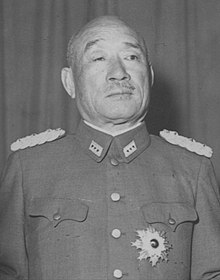This article includes a list of general references, but it lacks sufficient corresponding inline citations. (July 2020) |
You can help expand this article with text translated from the corresponding article in Japanese. (November 2024) Click [show] for important translation instructions.
|
Hajime Sugiyama | |
|---|---|
杉山 元 | |
 | |
| Minister of the Army Empire of Japan | |
| In office 9 February 1937 – 3 June 1938 | |
| Monarch | Shōwa |
| Prime Minister | |
| Preceded by | Kōtarō Nakamura |
| Succeeded by | Seishirō Itagaki |
| In office 22 July 1944 – 7 April 1945 | |
| Prime Minister | Kuniaki Koiso |
| Preceded by | Hideki Tojo |
| Succeeded by | Korechika Anami |
| Chief of the Imperial Japanese Army General Staff | |
| In office 3 October 1940 – 21 February 1944 | |
| Monarch | Shōwa |
| Prime Minister | |
| Preceded by | Prince Kan'in Kotohito |
| Succeeded by | Hideki Tojo |
| Personal details | |
| Born | January 1, 1880 Kokura, Fukuoka Prefecture, Japan |
| Died | September 12, 1945 (aged 65) Tokyo, Japan |
| Awards | Order of the Golden Kite, Order of the Rising Sun |
| Military service | |
| Allegiance | |
| Branch/service | |
| Years of service | 1901–1945 |
| Rank | |
| Commands | 12th Division Northern China Area Army First General Army |
| Battles/wars | |
Hajime Sugiyama (杉山 元, Sugiyama Hajime / Sugiyama Gen, January 1, 1880 – September 12, 1945) was a Japanese field marshal and one of Japan's military leaders for most of the Second World War.
As Army Minister in 1937, Sugiyama was a driving force behind the launch of hostilities against China in retaliation for the Marco Polo Bridge Incident. After being named the Army’s Chief of Staff in 1940, he became a leading advocate for expansion into Southeast Asia and preventive war against the United States.
Upon the outbreak of hostilities in the Pacific theater of World War II, Sugiyama served as the army’s de facto commander-in-chief until his removal by Prime Minister Hideki Tojo in February 1944. Following Tojo's ouster in July 1944, he once again held the post of Army Minister in Kuniaki Koiso's cabinet until its dissolution in April 1945. Ten days after Japan's surrender on 2 September 1945, he committed suicide.